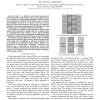Free Online Productivity Tools
i2Speak
i2Symbol
i2OCR
iTex2Img
iWeb2Print
iWeb2Shot
i2Type
iPdf2Split
iPdf2Merge
i2Bopomofo
i2Arabic
i2Style
i2Image
i2PDF
iLatex2Rtf
Sci2ools
TVLSI
2010
2010
Enhancing the Area Efficiency of FPGAs With Hard Circuits Using Shadow Clusters
There is a dramatic logic density gap between FPGAs and ASICs, and this gap is the main reason FPGAs are not cost-effective in high volume applications. Modern FPGAs narrow this gap by including "hard" circuits such as memories and multipliers, which are very efficient when they are used. However, if these hard circuits are not used, they go wasted (including the very expensive programmable routing that surrounds the logic) and have a negative impact on logic density. In this paper we propose a new architectural concept, called shadow clusters, that seeks to mitigate this loss. A shadow cluster is a standard FPGA logic "cluster" that is placed "behind" every hard circuit and can programmably, through simple, small multiplexers, replace the hard circuit in the event it isn't needed. We measure the area-efficiency of FPGAs with and without shadow clusters and show that a modern commercial architecture (with a fixed ratio of multipliers to soft logic) wo...
| Added | 22 May 2011 |
| Updated | 22 May 2011 |
| Type | Journal |
| Year | 2010 |
| Where | TVLSI |
| Authors | Peter A. Jamieson, Jonathan Rose |
Comments (0)

